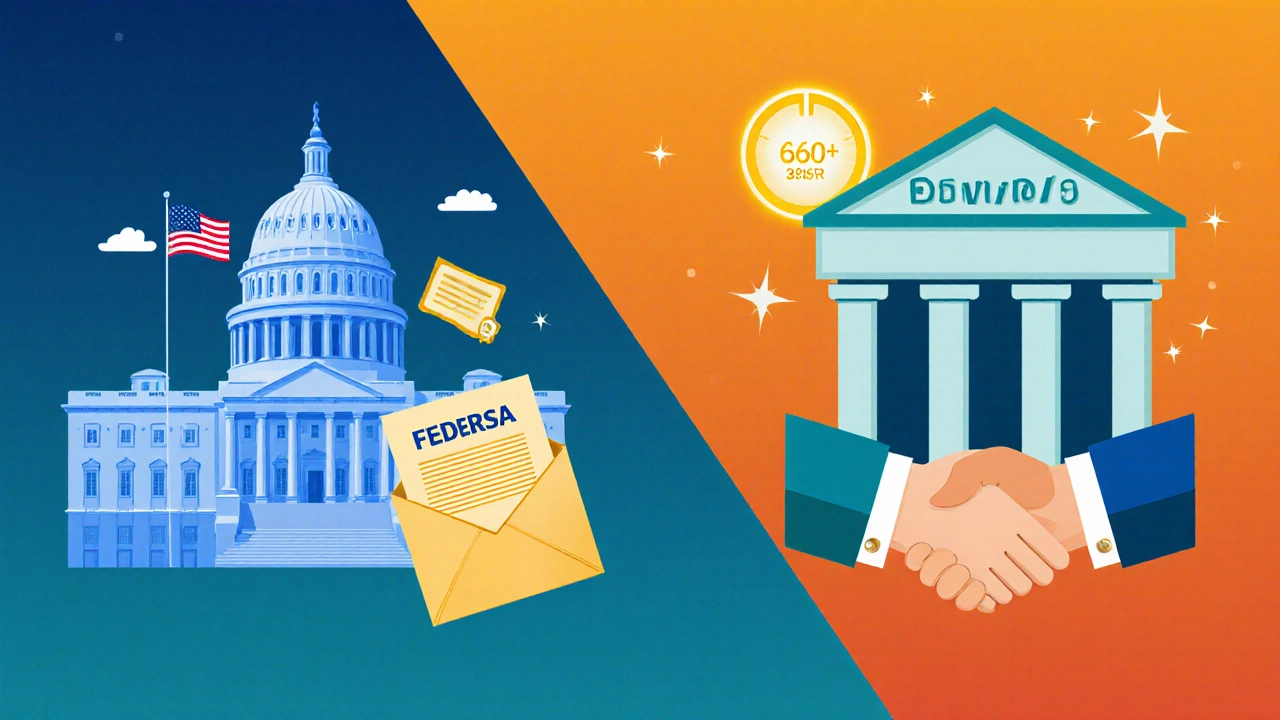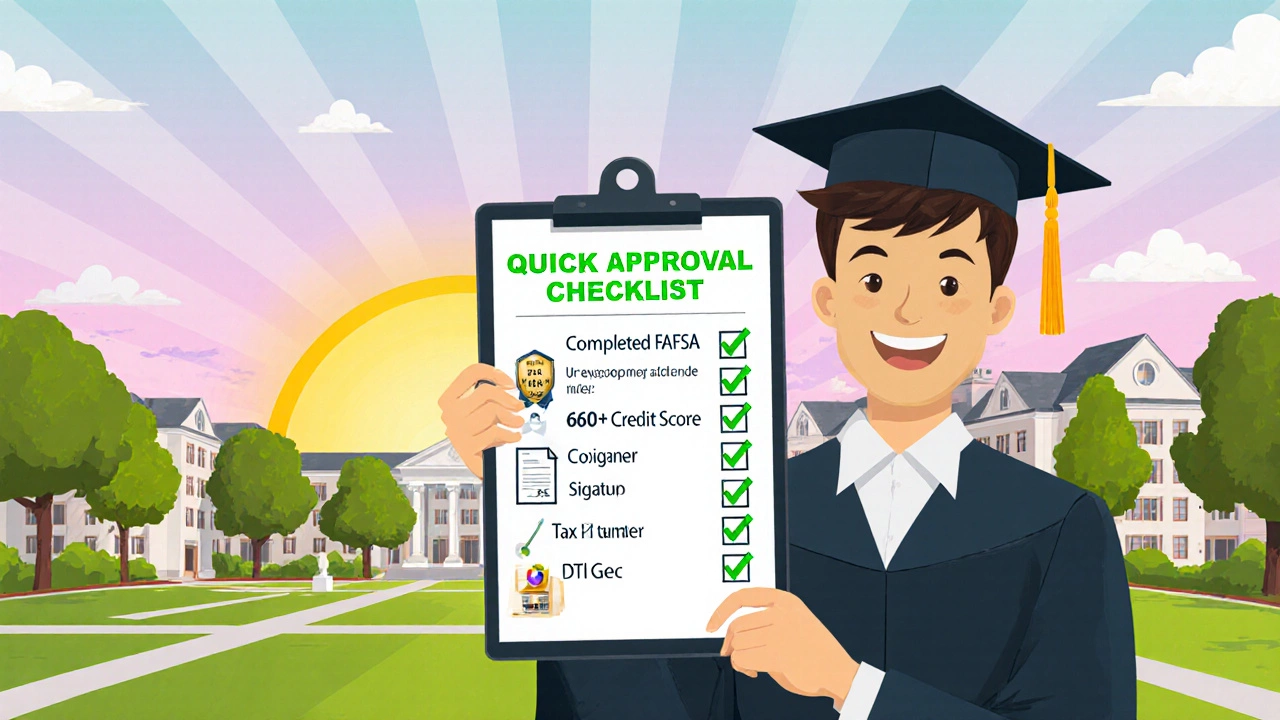Student Loan Approval Calculator
This calculator helps you determine your eligibility for student loans by calculating your debt-to-income ratio and checking if you meet the basic requirements for federal and private loans. Based on your inputs, you'll receive personalized guidance on how to improve your chances of approval.
Your Financial Information
Your Results
Debt-to-Income Ratio:
Federal Loan Eligibility:
Private Loan Eligibility:
Next Steps to Improve Your Chances
- Improve your credit score Recommended
- Lower your debt-to-income ratio Recommended
- Complete the FAFSA Required
When you’re staring at tuition bills, the first question that pops up is whether you’ll actually qualify for a student loan approval. The good news? Most students do get funded - but only if they meet a handful of clear requirements. Below we break down exactly what lenders look for, how federal and private options differ, and what you can do today to boost your odds.
Key Takeaways
- Federal loans are the easiest to qualify for; private loans need a solid credit profile.
- Credit scores of 660+ usually unlock the best private rates.
- Having a co‑signer can turn a denial into an acceptance.
- FAFSA completion is mandatory for any federal aid.
- Keep your debt‑to‑income (DTI) ratio below 45% for smoother approval.
How Loan Approval Works - A Quick Overview
- Complete the FAFSA (or a private lender’s application).
- The lender checks your credit score and credit history.
- They verify enrollment status and expected graduation date.
- Income, tax returns, and DTI are reviewed.
- If needed, a co‑signer’s information is added.
- Decision is sent - either approved, approved with conditions, or denied.
Understanding each step helps you anticipate where you might hit a snag.
Core Factors Lenders Evaluate
Below are the top five criteria that decide whether your loan application goes through.
Credit score is a three‑digit number ranging from 300 to 850 that summarizes your credit history. Federal loans don’t look at this number, but private lenders typically set a minimum of 660 for the most favorable rates. If you’re below that, expect higher interest or a co‑signer requirement.
Cosigner is a person, often a parent or relative, who guarantees repayment if you default. A strong co‑signer can offset a low credit score, opening doors to private loan offers that would otherwise be denied.
FAFSA is the Free Application for Federal Student Aid, required for any federal loan or grant. Missing or incorrectly filling out the FAFSA instantly disqualifies you from federal funds, so double‑check every field.
Income verification is documentation - such as tax returns or pay stubs - proving you (or your co‑signer) can afford the loan. Lenders compare this income to your total monthly debt to calculate the DTI ratio.
Debt‑to‑income ratio is the percentage of your monthly gross income that goes toward debt payments. A DTI under 45% is generally considered safe; higher ratios raise red flags.

Federal vs. Private Student Loans - What’s the Real Difference?
| Feature | Federal Student Loan | Private Student Loan |
|---|---|---|
| Credit Check | Not required | Required (usually 660+ for best rates) |
| Co‑signer Needed | Never | Often, especially for lower scores |
| Interest Rate Type | Fixed; subsidized rates for need‑based loans | Fixed or variable; depends on lender and credit |
| Repayment Flexibility | Income‑driven plans, deferment, forbearance | Limited; some lenders offer short grace periods |
| Application Process | FAFSA only | Individual lender applications, often online |
Because federal loans ignore credit scores, they’re the safest bet for most students. Private loans fill the gap when federal aid isn’t enough, but they bring stricter credit standards.
Tips to Strengthen Your Chances of Approval
- Boost your credit early. Pay off any existing credit‑card balances and keep utilization under 30%.
- File the FAFSA as soon as it opens (usually October 1). Early filing can snag more aid before funds run out.
- Ask a parent or close relative to co‑sign if your score is below 660.
- Gather all income documents before you start the application - tax returns, W‑2s, or recent pay stubs.
- Maintain a DTI below 45%; if it’s higher, consider paying down a small debt before applying.
Common Reasons for Denial and How to Fix Them
Even if you think you’re a perfect candidate, a few hidden issues can trigger a denial.
- Incomplete FAFSA. Missing fields cause the system to reject the application. Double‑check every line and use the online “save and return” feature.
- Low credit score. For private loans, a score under 660 usually means a higher rate or a denial. Improve by disputing errors on your credit report.
- High DTI. Lenders view a ratio above 45% as risky. Reduce by paying off a small loan or increasing income (part‑time work, scholarships).
- Missing enrollment verification. Schools must confirm you’re enrolled at least half‑time. Contact the financial aid office if the verification email never arrives.
- No co‑signer when needed. If the lender asks for a guarantor and you can’t provide one, the application stalls. Look for a parent willing to co‑sign or consider a credit‑builder loan first.

Alternatives If You’re Struggling to Get Approved
When loans don’t work out, there are still ways to cover tuition.
- Scholarships and grants. These don’t need repayment and often have minimal eligibility hurdles (e.g., field of study, community service).
- Work‑study programs. Offer part‑time jobs on campus that count toward financial aid.
- Payment plans. Many schools let you split tuition into monthly installments without interest.
- Credit‑builder loans. Small, low‑interest loans designed to improve your credit score quickly.
Mixing a few of these options with a modest federal loan can keep you from needing a high‑cost private loan.
Quick Approval Checklist
- Submit a complete FAFSA before the deadline.
- Check your credit score; aim for 660+ for private loans.
- Secure a co‑signer if your score is lower.
- Gather recent tax returns, W‑2s, and pay stubs.
- Calculate your DTI and aim for under 45%.
- Review enrollment verification from your school.
Cross each item off, and you’ll be in a strong position to get the money you need.
Frequently Asked Questions
Do I need a credit score for federal student loans?
No. Federal loans are based on need and enrollment status, not your credit history. That’s why they’re the easiest to qualify for.
What is a good credit score for a private student loan?
Most private lenders look for a score of 660 or higher to offer competitive rates. Scores below 600 often require a co‑signer or result in higher interest.
Can I apply for both federal and private loans at the same time?
Yes. Start with the FAFSA to lock in any federal aid, then shop around private lenders for any remaining gap. Lenders will look at the total amount you’re borrowing.
How long does the approval process take?
Federal loans are usually approved within a few weeks after FAFSA submission. Private loans can be instant online or take up to two weeks if manual review is needed.
What should I do if my loan is denied?
First, ask the lender for the specific denial reason. Then address that issue - improve your credit, add a co‑signer, or lower your DTI - before re‑applying or seeking alternatives.

